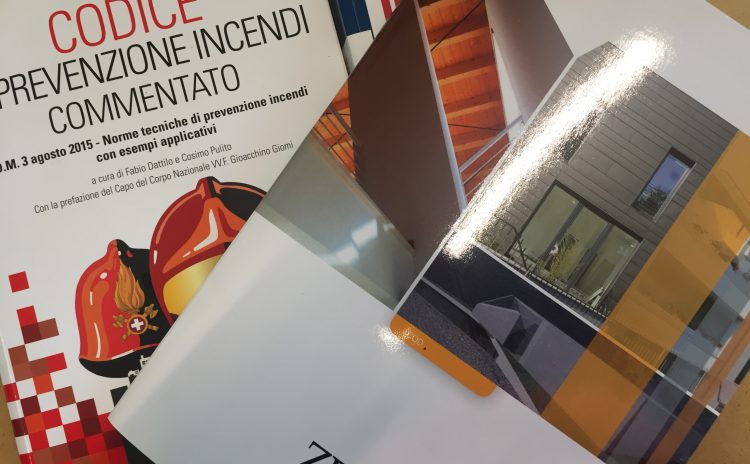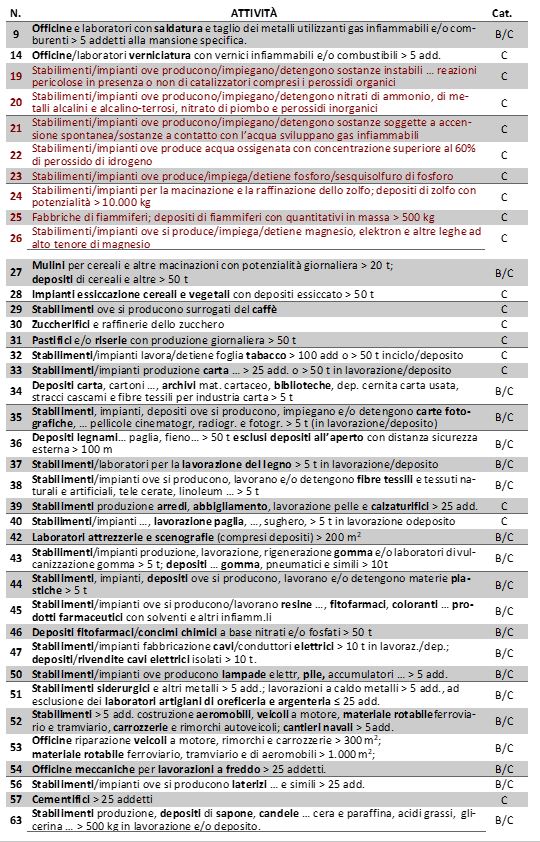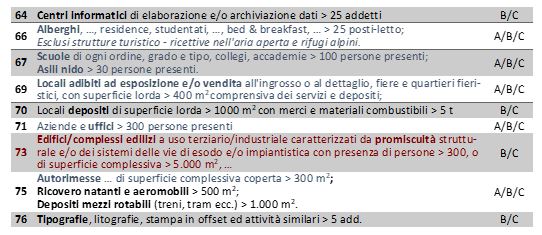IL CODICE DI PREVENZIONE INCENDI E LA SUA APPLICABILITA ALLE ATTIVITA’ INTERESSATE DALLA NORMATIVA ANTINCENDIO
THE FIRE PREVENTION CODE AND ITS APPLICABILITY TO ACTIVITIES AFFECTED BY FIRE REGULATIONS
- 04 Ott 2020

La normativa antincendio in Italia, come anche quella relativa ad altre tematiche, è stata caratterizzata dal “consueto” proliferare di Decreti, Leggi, Circolari esplicative,… spesso ridondanti ed anche in alcuni casi contraddittori, che ne hanno spesso reso difficile la comprensione e l’applicazione, dovendo confidare, alla fine, sempre nel rapporto con il funzionario di turno del Comando di competenza. Questo ha creato le solite annose e burocraticamente deleterie differenze tra Provincia e Provincia e tra Regione e Regione in uno Stato che, almeno per la prevenzione incendi, dovrebbe dirsi unitario.
Nel tentativo di dare finalmente una semplificazione ed una uniformità interpretativa ci sono stati comunque due “recenti” momenti legislativi fondamentali:
1. EMANAZIONE DEL DPR 151/2011 che sostituisce il DM 16/02/1982 ed il DPR 689/1959 ed opera in relazione delle attività soggette al controllo dei Vigili del Fuoco e quindi al rilascio del Certificato di Prevenzione Incendi. Tale DPR, del 01/08/2011, ha riguardato tre ambiti fondamentali:
1.A. Ambito attività soggette, tramite:
- Indicazione di attività non più soggette
- Introduzione di nuove attività soggette
- Creazione di accorpamenti di più attività soggette
Di fatto si è passati da 97 ad 80 attività (indicate nell’Allegato I del DPR 151/2011), assoggettandovi anche le attività industriali a rischio d’incidente rilevante (r.i.r.) di cui all’art. 8 del D.Lgs n. 334/1999 e s.m. (ora Direttiva Seveso III)
1.B. Introduzione del concetto di proporzionalità e semplificazione, tramite:
. Suddivisione, per ogni attività, in tre categorie in base al livello di pericolosità, ossia
- Categoria A: attività dotate di ‘regola tecnica’ e con limitato livello di complessità (ci sono alcune eccezioni di attività A senza regola tecnica: 12/A Depositi e/o rivendite di liquidi con punto di infiammabilità > 65 °C per capacità geometrica complessiva tra 1 m3 e 9 m3, 41/A ….)
- Categoria B: Attività dotate di ‘regola tecnica’ con maggiore complessità o sprovviste, ma con livello di complessità inferiore rispetto alla cat. C.
- Categoria C: attività con alto livello di complessità, indipendentemente da una ‘regola tecnica’.
. Definizione in base alla categoria di procedimenti differenziati (utilizzo della SCIA antincendio per iniziare l’attività senza attendere la visita dei Vigili del Fuoco), ossia:
- Categoria A:
- No Esame progetto (solo SCIA);
- Sopralluogo a campione (a richiesta rilascio verbale di visita tecnica).
- Categoria B:
- Esame progetto + SCIA;
- Sopralluogo a campione (a richiesta rilascio verbale di visita tecnica).
- Categoria C:
- Esame progetto + SCIA;
- Sopralluogo obbligatorio (rilascio “CPI”).
1.C. Definizione (in realtà già esistenti) di modalità uniformate per la presentazione delle pratiche (modelli PIN, DICH, CERT…)
2. EMANAZIONE DEL “CODICE DI PREVENZIONE INCENDI” tramite il DM 03/08/2015 (di cui ne costituisce l’Allegato 1) ed entrato in vigore il 18/11/2015 che è finalizzato fondamentalmente a:
- dare una riorganizzazione alle innumerevoli regole tecniche di prevenzione incendi emanate nel tempo su varie attività creando un Testo Unico sulla normativa antincendio
- permettere alla progettazione antincendio di utilizzare un approccio di tipo prestazionale
- favorire l’utilizzo dei metodi dell’ingegneria antincendio
In termini complessivi, il Codice comprende 4 sezioni:
G. Definizioni
S. Strategia antincendio – norme antincendio generali (le Regole Tecniche Orizzontali – RTO)
V. Regole tecniche verticali – norme antincendio specifiche per determinate attività (le Regole Tecniche Verticali – RTV).
M. Metodi – Ingegneria della sicurezza antincendio
Dal 2015 sino ad oggi il DM 03/08/2015 e quindi il Codice sono stati oggetto di una serie di aggiornamenti normativi, revisioni ed allineamenti. La situazione attuale (ad oggi ed a partire dalla data del 20/10/2019) è la seguente:
2.A. Il Codice di Prevenzione Incendi si applica ad alcune (47) delle attività soggette al controllo dei Vigili del Fuoco tra le 80 indicate nell’Allegato I del DPR 151/2011) e specificatamente alle attività individuate con i numeri: 9; 14; da 19 a 40; da 42 a 47; da 50 a 54; 56; 57; 63; 64; 66, ad esclusione delle strutture turistico-ricettive all’aria aperta e dei rifugi alpini; 67; da 69 a 71; 73; 75; 76. Ossia:


Di queste:
- Quelle (42) che sono “attività non normate” ossia che non presentano una norma antincendio specifica (emanata / aggiornata nel tempo), devono seguire le indicazioni del Codice (RTO) come unica norma obbligatoria
- Quelle (5) che sono “attività normate” ossia che presentano una norma antincendio specifica (emanata / aggiornata nel tempo), possono utilizzare le indicazioni del Codice relative a quella attività (RTV) oppure in alternativa la relativa norma prescrittiva tradizionale specifica. Unica attuale eccezione è l’attività relativa alle autorimesse che dal 19/11/2020 dovrà seguire solo la norma specifica presente nel Codice
Per le 47 attività attualmente soggette al Codice di Prevenzione incendi si può distinguere tra:
- Attività di nuova realizzazione (realizzate successivamente al 20/10/2019).
- Senza RTV: Codice obbligatorio
- Con RTV: Si può optare tra Codice o Regole tradizionali
- Attività esistenti (realizzate prima del 20/10/2019).
- Attività già “definite”: Nessun obbligo di adeguamento.
- Per modifiche/ampliamenti “compatibili”: Codice sulla parte modificata
- Per modifiche/ampliamenti “non compatibili” si può optare:
- adottando Disposizioni tradizionali;
- applicando il Codice sull’intera attività.
2.B. Il Codice di Prevenzione Incendi non si applica alle restanti (33) attività soggette al controllo dei Vigili del Fuoco tra le 80 indicate nell’Allegato I del DPR 151/2011) e specificatamente le attività individuate con i numeri: 1÷8, 10÷13, 15÷18, 41, 48÷49, 55, 58÷62, 65, 68, 72, 74, 77÷80 nonché le 66 relative a strutture turistico-ricettive all’aria aperta e dei rifugi alpini. Per queste attività si deve far riferimento alla norma specifica se esistente (ad esempio, per attività 77 edifici con più di 24 m di altezza antincendio si deve far riferimento al DM. 16/5/1987 n. 246 coordinato con le modifiche e le integrazioni introdotte dal D.M. 15/9/2005). Se invece la norma non esiste si deve operare come prima dell’emanazione del Codice ossia facendo riferimento ai criteri generali di prevenzione presenti nel DM 30/03/1998 e smi, alla propria esperienza ed, eventualmente, ma solo come riferimento e non come obbligo, al Codice in questione.
Per le 33 attività attualmente non soggette al Codice di Prevenzione incendi si può distinguere, per uniformità all’impostazione precedente, tra:
- Attività di nuova realizzazione (realizzate successivamente al 20 ottobre 2019).
- Senza RTV: come sopra (DM 30/03/1998, esperienza, Codice)
- Con RTV: Regole tradizionali
- Attività esistenti (realizzate prima del 20 ottobre 2019).
- Attività già “definite”: Nessun obbligo di adeguamento.
- Per modifiche/ampliamenti in mancanza di RTV:
- come sopra (DM 30/03/1998, esperienza, Codice)
- Per modifiche/ampliamenti in presenza di di RTV:
- adottare Disposizioni tradizionali;
2.C. Viene riportato (art.2 co.5 DM 03/08/2015 – Articolo così sostituito dal comma 1 dell’art. 2 del DM 12/04/2019 entrato in vigore il 20/10/2019) in modo molto generico che il Codice può (ossia non è un obbligo) essere utilizzato per attività che non rientrano nell’ambito di assoggettabilità del DPR 151/2011. Questo significa che potrebbe essere utilizzato sia per attività sottosoglia che presentano norme antincendio specifiche che le riguardano (ad esempio, un edificio nuovo da realizzarsi con altezza antincendio uguale o superiore a 12 m ma inferiore o uguale a 24 m è soggetto a norma antincendio specifica ma non è soggetto al DPR 151/2011 a e quindi potrebbe essere progettato in relazione alla problematica antincendio in base al Codice di Prevenzione incendi) sia per qualsiasi attività in senso lato (?…). Di fatto, tale indicazione può significare principalmente che il Codice può essere utilizzato come ausilio per soluzioni alternative nelle richieste di deroga per attività normate sottosoglia.
 Ing. Paolo Croce- ZED PROGETTI srl
Ing. Paolo Croce- ZED PROGETTI srl
The fire regulations in Italy, as well as those relating to other issues, has been characterized by the “usual” proliferation of Decrees, Laws, Explanatory Circulars,… often redundant and even in some cases contradictory, which have often made them difficult to understand and apply, having to rely, in the end, always in the relationship with the official on duty of the Command of competence. This has created the usual long-standing and bureaucratically deleterious differences between Province and Province and between Region and Region in a State which, at least for fire prevention, should be called unitary.
In an attempt to finally give a simplification and uniformity of interpretation there have been, however, two “recent” fundamental legislative moments:1. EMANATION OF DPR 151/2011 which replaces DM 16/02/1982 and DPR 689/1959 and operates in relation to the activities subject to the control of the Fire Brigade and therefore the issue of the Fire Prevention Certificate. This Presidential Decree, dated 01/08/2011, concerned three fundamental areas:
1.A. Scope of activities subject to, through:
Indication of activities no longer subject
Introduction of new activities subject to
Creating mergers of multiple subject activities
In fact, the number of activities has risen from 97 to 80 (indicated in Annex I of Presidential Decree 151/2011), including industrial activities at risk of major accidents (r.i.r.) pursuant to Article 8 of Legislative Decree no. 334/1999, as amended. (now Seveso III Directive)1.B. Introduction of the concept of proportionality and simplification, through
. Subdivision, for each activity, into three categories according to the level of dangerousness, namely
Category A: activities with ‘technical rule’ and with limited level of complexity (there are some exceptions of activities A without technical rule: 12/A Deposits and/or resales of liquids with flash point > 65 °C for total geometric capacity between 1 m3 and 9 m3, 41/A …)
Category B: Activities with a ‘technical regulation’ with greater complexity or without one, but with a lower level of complexity than category C.
Category C: Activities with a high level of complexity, independently of a ‘technical rule’.. Definition according to the category of differentiated procedures (use of the fire-fighting SCIA to start the activity without waiting for the visit of the Fire Brigade), that is:
Category A:
No Project examination (SCIA only);
Random inspection (on request issue of a technical inspection report).
Category B:
Project examination + SCIA;
Random inspection (on request issue of technical visit report).
Category C:
Project examination + SCIA;
Mandatory inspection (“CPI” issue).
1.C. Definition (in reality already existing) of uniform procedures for the presentation of files (PIN, DECLARATION, CERT…).2. EMANATION OF THE “FIRE PREVENTION CODE” by means of DM 03/08/2015 (of which it constitutes Annex 1) and entered into force on 18/11/2015, which is basically aimed at
to reorganise the countless technical fire prevention rules issued over time on various activities by creating a Consolidation Act on fire prevention regulations
allow fire design to use a performance approach
encourage the use of fire engineering methods
In overall terms, the Code comprises 4 sections:G. Definitions
S. Fire strategy – general fire regulations (Horizontal Technical Rules – RTO)
V. Vertical Technical Rules – fire regulations specific to certain activities (the Vertical Technical Rules – RTV).
M. Methods – Fire Safety Engineering
From 2015 until today the Ministerial Decree 03/08/2015 and therefore the Code have been subject to a series of regulatory updates, revisions and alignments. The current situation (to date and as of 20/10/2019) is as follows:
2.A. The Fire Prevention Code applies to some (47) of the activities subject to the control of the Fire Brigade among the 80 indicated in Annex I of Presidential Decree 151/2011) and specifically to the activities identified with the numbers: 9; 14; from 19 to 40; from 42 to 47; from 50 to 54; 56; 57; 63; 64; 66, with the exclusion of open-air tourist accommodation facilities and mountain huts; 67; from 69 to 71; 73; 75; 76.
Of these:
Those (42) which are “non-standard activities”, i.e. which do not have a specific fire safety standard (issued / updated over time), must follow the indications of the Code (RTO) as the only mandatory standard.
Those (5) that are “standardised activities”, i.e. that have a specific fire safety standard (issued / updated over time), may use the indications of the Code relating to that activity (RTV) or alternatively the relevant specific traditional prescriptive standard. The only current exception is the activity related to garages that from 19/11/2020 will have to follow only the specific standard present in the Code.For the 47 activities currently subject to the Fire Prevention Code, a distinction can be made between:
New activities (carried out after 20/10/2019).
Without RTV: Mandatory code
With RTV: You can choose between Code or Traditional Rules
Existing activities (carried out before 20/10/2019).
Activities already “defined”: No need for adaptation.
For ‘compatible’ amendments/extensions: Code on the amended part
For modifications/extensions “not compatible” you can opt for:
adopting traditional provisions;
applying the Code to the whole activity.2.B. The Fire Prevention Code does not apply to the remaining (33) activities subject to the control of the Fire Brigade among the 80 indicated in Annex I of Presidential Decree 151/2011) and specifically the activities identified with the numbers: 1÷8, 10÷13, 15÷18, 41, 48÷49, 55, 58÷62, 65, 68, 72, 74, 77÷80 as well as the 66 related to open-air tourist accommodation facilities and mountain huts. For these activities, reference should be made to the specific standard if existing (for example, for activities 77 buildings with more than 24 m fire height, reference should be made to the DM. 16/5/1987 n. 246 coordinated with the modifications and integrations introduced by the D.M. 15/9/2005). If, on the other hand, the standard does not exist, it must be operated as before the issue of the Code, i.e. by referring to the general prevention criteria contained in the Ministerial Decree 30/03/1998 and subsequent amendments, to one’s own experience and, possibly, but only as a reference and not as an obligation, to the Code in question.
For the 33 activities currently not subject to the Fire Prevention Code, a distinction can be made, for the sake of uniformity with the previous approach, between
New activities (carried out after 20 October 2019).
Without RTV: as above (DM 30/03/1998, experience, Code)
With RTV: Traditional rules
Existing activities (carried out before 20 October 2019).
Activities already “defined”: No need for adaptation.
For modifications/extensions in the absence of RTV:
as above (DM 30/03/1998, experience, Code)
For modifications/extensions in the presence of RTV:
adopt traditional provisions;2.C. It is reported (art.2 co.5 DM 03/08/2015 – Article thus replaced by paragraph 1 of art. 2 of DM 12/04/2019 entered into force on 20/10/2019) in a very general way that the Code can (i.e. it is not an obligation) be used for activities that do not fall within the scope of DPR 151/2011. This means that it could be used both for sub-threshold activities that have specific fire regulations that concern them (for example, a new building to be constructed with a fire height equal to or greater than 12 m but less than or equal to 24 m is subject to specific fire regulations but is not subject to Presidential Decree 151/2011 to and therefore could be designed in relation to fire prevention issues under the Fire Prevention Code) and for any activity in the broad sense (?…). In fact, this indication may mainly mean that the Code can be used as an aid for alternative solutions in derogation requests for sub-threshold standard activities.

